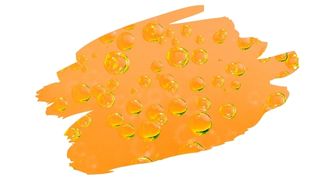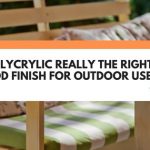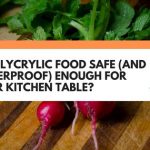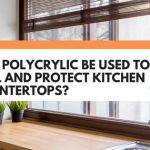Wood finishing is both the simplest and trickiest part of woodworking. And a lot of things can go wrong while you’re waiting for that top coat to dry.
In fact, everything from humidity to dust in the air, can turn an otherwise smooth finish into something less than perfect. But, sometimes you can do everything right, and a finish still doesn’t turn out the way you want.
Let’s take for example when lots of tiny bubbles form on a Polycrylic finish. What causes it? And how can you fix it — or better yet — stop it from happening in the first place?
Well, in this post, you’ll learn why air bubbles can appear in a Polycrylic finish. You’ll also find out which four preparatory steps you can take to prevent those bubbles from marring that final Polycrylic coat.
And keep reading to discover the most practical way to remove air bubbles from an already dry Polycrylic finish.

This post may contain affiliate links to products that we receive a commission for (at no additional cost to you). Learn more here.
What Causes Polycrylic To Bubble In The First Place?
Usually the reason why those bubbles appear is because you may have shaken the can beforehand. Shaking the can creates little air bubbles in that Polycrylic liquid.
Another reason could be that the paint, stain or finish underneath the Polycrylic hasn’t cured yet.
You see, as that paint/stain/finish underneath continues to cure, it’ll release fumes (also known as Volatile Organic Compounds). And those fumes can form trapped bubbles in the Polycrylic finish that’s sealing them.
Last, but not least, another cause for bubbles can stem from improper brush preparation. You always need to prep a brush before you apply Polycrylic. And you do this by dipping it in water first, before you go dipping it into water-based Polycrylic.
Related Post: Is Polycrylic Food Safe (And Waterproof) Enough For Your Kitchen Table?
OK. So How Do You Avoid Air Bubbles In Polycrylic?
Well, the best way to avoid air bubbles is by following best application practice:
1). Stir (Never Shake)
If that Polycrylic has settled in the can, then stir it around. Never shake the can.
2). Wait For The Base Coat To Cure
If you are applying Polycrylic as a seal over another finish, then wait for that finish to dry and cure first.
This is especially important when applying over very slow-curing finishes, such as Tung oil or Raw Linseed oil. Both of these natural oil wood finishes can take up to 30 days to cure.
3). Dip The Brush (Or Rag) In Water
Always dip the brush in water — and squeeze away any excess water off the brush — before you dip it into the can.
4). Avoid Foam Brushes!
These particular types of brushes are the worst culprits for leaving behind tiny air bubbles in finishes such as Polycrylic.
Stick to using a quality bristle brush (ideally) or a rag to apply this finish onto the surface of wood.
Related Post: Should You Even Bother Applying Polyurethane Over Polycrylic?
The Finish Already Has Bubbles On It. How Do You Get Bubbles Out Of A Polycrylic Final Coat?
If the bubbles are already in that finish, all thats left to do is to try and slow down the rate of drying. You see, those bubbles will naturally pop without you having to do anything — but only if they have enough time to do so.
So, letting the finish dry in a cooler area is one option. Nevertheless, it is not the most practical course of action — especially as Polycrylic already dries fairly quickly.
In which case, your only option is to wait for the Polycrylic to dry (around 2-3 hours), and then sand out those bubbles.
So, once the Polycrylic is dry, use 80-grit sandpaper to remove those troublesome bubbling sections. Afterwards, use 100-grit to 120-grit sandpaper to smooth and even out the surface.
And then finally, you can apply a fresh final top coat of Polycrylic.
Related Post: Is Polycrylic Really The Right Wood Finish For Outdoor Use?
Got It… But Is There A Way To Pop Air Bubbles In Polycrylic While It’s Still Wet?
You can try popping each and every bubble using the tip of your brush.
This method is time-consuming — and can become frustrating fairly quickly. Plus you’d have to be quick about it too, as the clock will be ticking down on that Polycrylic drying.
But if you have the patience, then first off, kudos to you. And second of all, yes, this method will work to remove those air bubbles from a still wet Polycrylic finish.
To Wrap Up, Here Are The 3 Key Takeaways From This Post…
- 1). Air bubbles in a Polycrylic finish can be caused by a number of different things. But, the main reason is usually due to having shaken the can with the Polycrylic finish still in it.
- 2). If you want to avoid air bubbles in this finish, don’t shake the can. And apply it using a bristle brush — do not use a foam brush.
- 3). If Polycrylic has dried with air bubbles in it, you’ll need to sand those bubbles away. Afterwards, you can reapply the final top coat.



